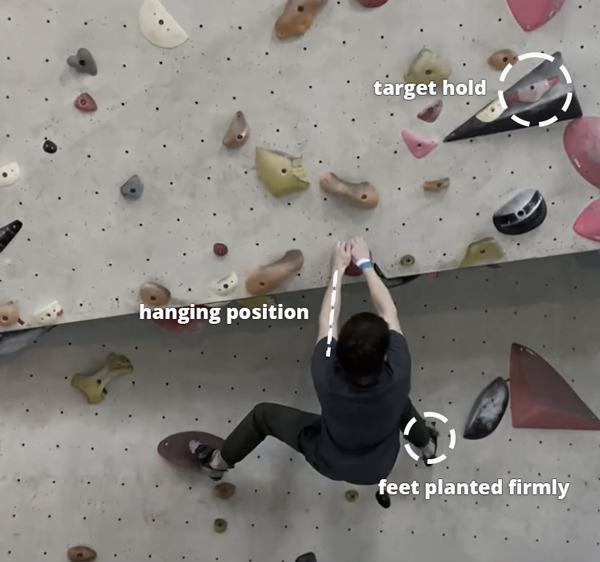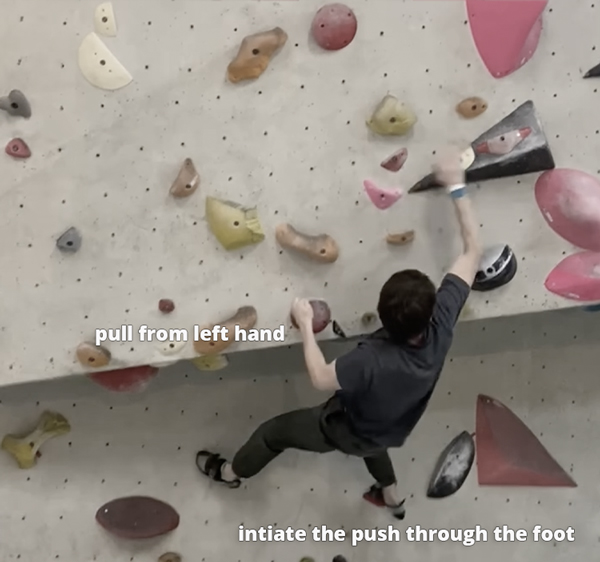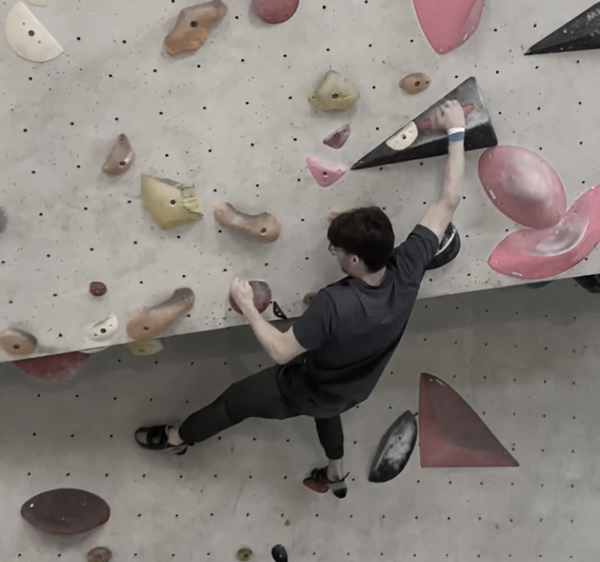Deadpointing is an advanced climbing technique that every climber should have in their arsenal. Not only will this move make you climb more efficiently, but it will also help you get out of bad positions and vastly increase your reach on the rock.
📚 This article is part of a wider guide: Climbing Technique 101
What is Deadpointing?
Deadpointing is a dynamic climbing move that is used when the next hold is too far away to reach statically. The climber leverages momentum by pushing off their legs and pulling with their hands, transitioning from a hanging position to a lunge for the next hold. This brief moment where the climber is weightless is known as the deadpoint, hence the name.
In theory, deadpoint in rock climbing actually refers to the moment of weightlessness during a dynamic movement, not just the dynamic move itself.
Deadpointing is more commonly known as climbing dynamically. Many climbers may have employed this technique without realizing its specific name. Now that you are aware of the term, you will be able to accurately respond if someone asks about deadpointing in the future.
The Deadpoint is an advanced climbing technique that enables climbers to reach holds they wouldn’t be able to reach otherwise, through a combination of speed, coordination, and precision.
Deadpointing should not be mistaken for a dyno, where limbs are removed from the wall in order to jump to the next hold. During a deadpoint, the climber still has body parts remaining on the wall (i.e. the pushing leg, and pushing hand)
Deadpointing is something all climbers have to learn at some point. But some climbers will be forced to learn it much sooner than others. (Though all would benefit from it!) I am of course talking about short climbers.
Short climbers don’t have a lot of reach and commonly lack the arm span the route setter intended for a boulder problem. Repeatedly, short climbers will find themselves unable to reach far-away holds that were meant to be within static reach. This is extremely frustrating (I would know, I’m short) but this frustration fades away once you master the deadpoint.
Deadpointing allows shorter climbers to extend their reach – by a lot. But it is not just useful for shorter climbers, it can come in handy for all types of climbers.
how to perform a deadpoint
There are a number of steps involved in performing a deadpoint. First, ensure that your feet are stable enough to generate a strong push. Next, hang from the starting hold with straight arms. While looking at the target hold, push your feet and pull from the remaining hand as you lunge forward in the direction of the target hold.
It should look something like this:
Notice how I start from a hanging position followed by an explosive movement towards the target hold. I’m pushing my right leg and simultaneously pulling from my left hand to generate enough momentum to reach the target hold. (Btw, I’m pushing from two footholds in this example, you can also push from a single foothold)
As Curious Doc eloquently describes it:[1] ‘there should be a compression phase followed by an explosive extension phase where the forward momentum of the body propels you in the direction you want to go.’
Let’s break it down.
1. Start from a crouched position

To prepare for the momentum, start from a hanging position with straight arms and hips away from the wall. Your feet should be firmly placed on top of the foothold(s).
2. push your feet and thrust the hip

Initiate the momentum by pushing through your feet followed by pulling from your hands.
3. lunge for the next hold

Finish the deadpoint by reaching for the target hold. Maintain body tension throughout the entire movement.
common mistakes while deadpointing
Deadpoints are tricky and require a combination of coordination, speed, and accuracy. It takes a while to get it right and you might make some mistakes. Here are three big mistakes that will prevent you from doing a proper deadpoint.
using bent arms
A lot of climbers keep their arms bent before making a dynamic move. This prevents you from being able to hang and make an explosive movement. You need to hang from your arms to be able to generate enough force to reach your target hold.
not using the feet
Oftentimes beginners attempt to make dynamic moves using their arms. With just your arms you can’t generate the explosiveness required to reach your target.
no using momentum
You can use your feet and still not have enough momentum required to land that final hold. In this case, you are likely lacking the explosive element of the deadpoint.
Ensure you drop down before you lunge forward.
practicing the deadpoint
It takes a bit of practice to learn, and master the deadpoint. You likely won’t learn this technique in one session and that’s okay. That’s why it’s an advanced technique after all. In addition to practicing the deadpoint head-on, here are some ways you can train your body to get ready for dynamic moves.
Practice moving from your feet
As opposed to your arms, the muscles in your legs are huge. That’s why we use our legs to do the heavy lifting during a deadpoint. By pushing from the leg, we are able to generate a ton of explosive power, without fatiguing our arms. Hence why deadpoints are so energy-efficient!
We’ll need to turn this pushing movement into muscle memory. And the best way to do this is to isolate the feet in some feet-only climbing drills.
Start on easy boulder problems and practice climbing only with your feet. Instead of reaching with your hands and fatiguing your arms, push from your feet. You’ll still grab the handholds, but you won’t be reaching for them in a static way. Ensure that your feet are doing ALL the work.
Move up from the easy problems and continue using your feet. Remember: your legs are doing the work. If you feel pumped, you are not using your feet!
This might feel weird at first if you are not used to climbing feet-first, but slowly you will adjust and develop muscle memory.
Practice body tension
Being an advanced technique, it’s hard to learn the deadpoint if you still struggle with holding body tension on the wall. Or if you don’t understand what body tension is in the first place.
Simply put, body tension refers to the act of using the muscles in one’s body to maintain balance and control while climbing.
This kind of control over your body is key to performing a deadpoint.
If your foot often slips while climbing and you frequently cut loose you probably have to work on your body tension. This is something that has to be acknowledged and trained. It starts with being aware of your body while you are climbing.
Foot slips are a result of not pushing through the feet. You are too focused on the next move that you forget about your feet below you. This kind of awareness has to be drilled in every climbing session until it becomes muscle memory.
While body tension is mainly trained through practice, it does require a level of core strength. If you feel like your core could use some extra help, check out our core exercises for climbers.
when to use the deadpoint
The deadpoint is a core climbing technique that should be utilized by all kinds of climbers. Here are situations when the deadpoint proves most beneficial.
next hold is out of reach
The most common use case of the deadpoint is when a hold is too far away and cannot be reached statically. Even a hold that seems impossibly far away for a hand to reach, can be unlocked through the deadpoint technique.
As mentioned earlier, short climbers will find the need to use the deadpoint technique more often than tall climbers.
save energy
Many climbers use the deadpoint even when holds are close together. This is because dynamic moves can save a lot of energy by pushing through the legs (large muscles) while climbing statically requires a lot of upper body strength (smaller muscles).
In this short video, Movement for Climbers explains how efficient the deadpoint can be as opposed to static climbing.
moving from a poor position
Sometimes climbs will put us in a weird, unhelpful position. Imagine you have a hand and foothold on the same side. In such case, your Center of Gravity sits outside of your Base of Support (your contact on the wall) you will likely barn door out. At this point, you can use a back flag to counteract the swing. But that doesn’t grant you the next handhold just yet. If you want to reach the next move from this position, you will have to use momentum and rely on the deadpoint to latch on the next hold.
Climbing Technique 101
Knowledge is power! Enhance your climbing progress by exploring our other articles on Climbing Techniques.
References
- Biomechanics of the deadpoint technique in climbing (youtube video)
- 20 Neil Greshams Masterclass – Deadpointing (youtube video)
- (Climbing Analysis) Technique Over Strength – The Efficiency of the Deadpoint (youtube video)